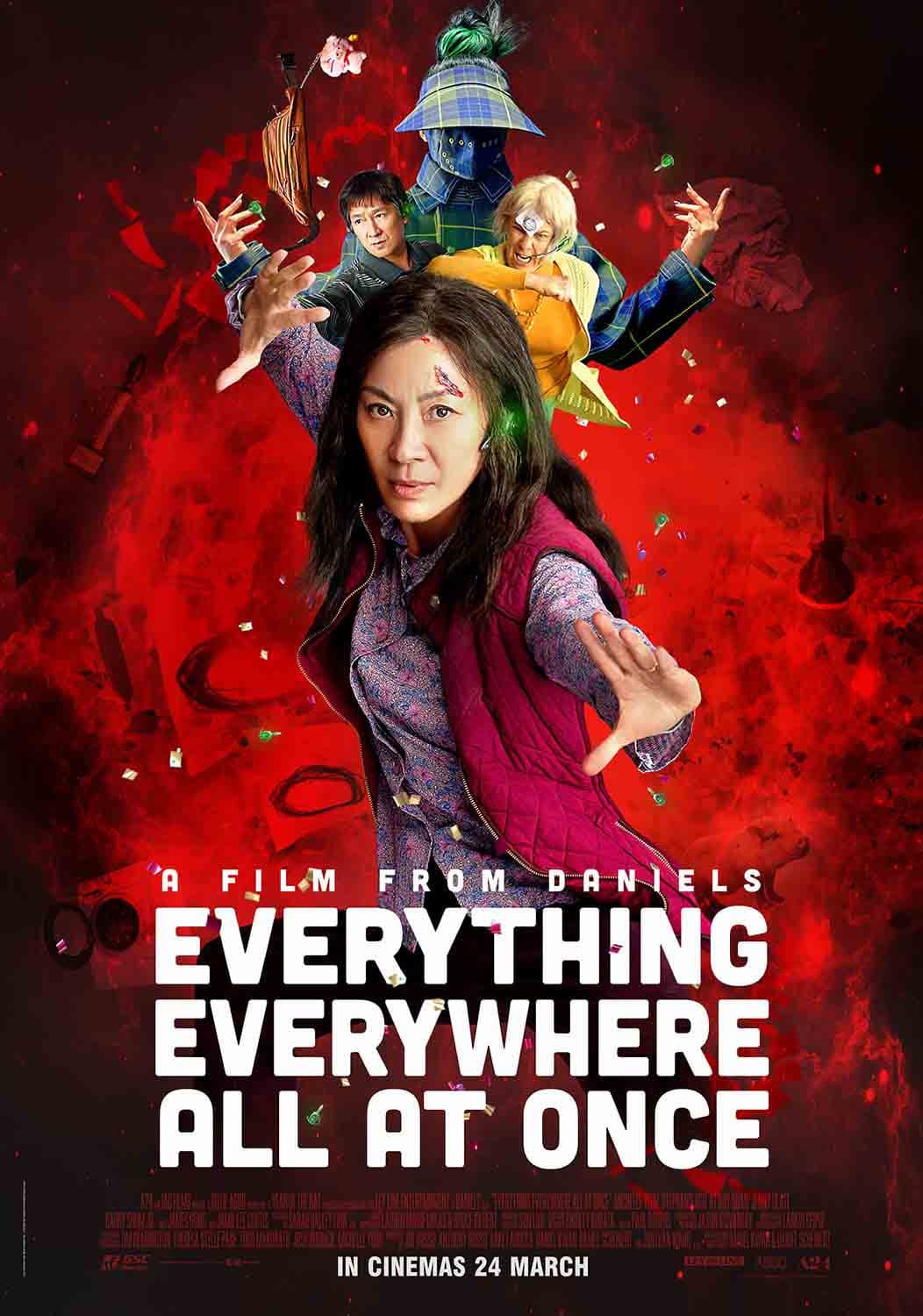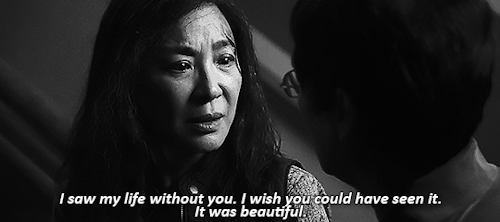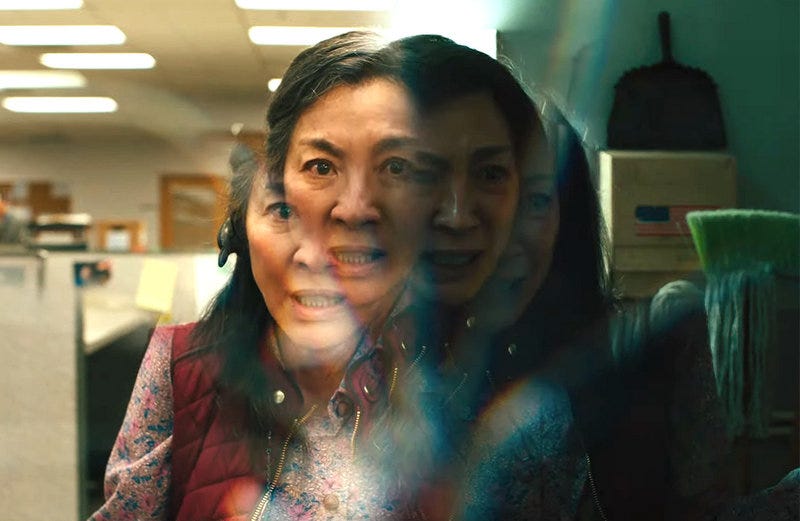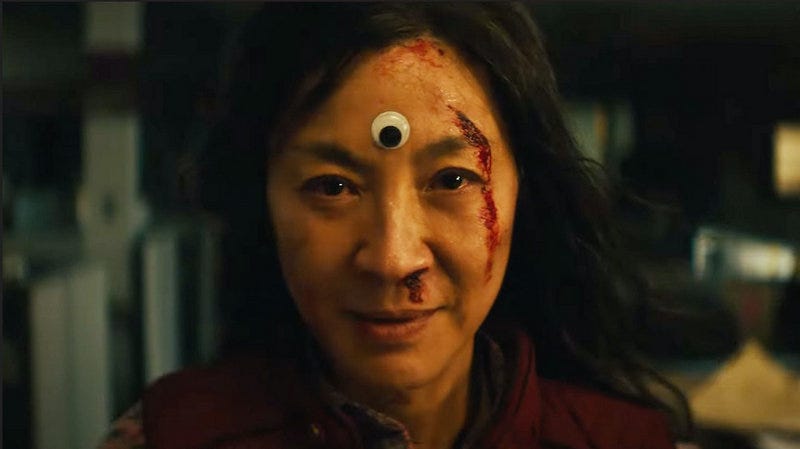The Magic Of Everything Everywhere All At Once
The most ludicrous film to ever be nominated for an Oscar might also be the smartest and most hopeful.
Hello! This is Everything Is Amazing, a newsletter about science, attention, wonder, curiosity and highly unlikely cities at the bottom of the sea…
And around this time last week, for the first time in my life, I saw the Northern Lights (Aurora Borealis). But then, a lot of people in the UK did. They were visible from just about everywhere, cloud-cover permitting:


That’s an unusual thing for the UK (usually, it’s only folk in the north of Scotland who get to see them) - but rarer still was the colour, which you can just see in the Stonehenge pic: an upper layer of glowing pink-red. (An explanation is here.)
Alas, in my case, I was too near the street lights and too late in catapulting myself out the door - but I did get to see a residual grey-green band of pulsing light a little above the horizon.
However, the best view of the night must have been from the window of this EasyJet flight from Iceland to England:




So: whew. I hope you agree that the real world is amazing.
But in the interests of curiosity and wonder, let’s take a look far beyond it.
There’s a moment about forty-five minutes into the film Everything Everywhere All At Once that seems like it’s summing up human existence in a really bleak way.
Evelyn Quan Wang (Michelle Yeoh) has just sent the villain of the story flying headfirst through a wall, using martial arts skills she never knew she had. Her confusion is understandable, because she genuinely never had them, and technically still doesn’t. She’s not a wuxia action film star - she’s a stressed-to-the eyeballs laundromat owner on the verge of bankruptcy.
But Evelyn has just discovered her connection to the multiverse, an endless expanse of alternate realities sitting alongside this one (representing a genuine branch of scientific inquiry)- and she has just learned to “download”, Matrix-style, the skills of one of her multiversal alter-egos…who just so happens to be a successful, glamorous martial arts action film star not unlike Michelle Yeoh in real life.
Just for a second, Evelyn looks out of the eyes of that Other Evelyn, as she attends some star-studded film premiere that looks an awful lot like a screening at the Oscars - and then, with a thump, she returns to her body in the here & now.
She starts crying.
Her husband (Ke Huy Quan) asks her what’s wrong - and she turns and looks at him, without really seeing him:
“I saw my life…without you. I wish you could have seen it. It was beautiful. I wish I had listened to my father and not gone with you, all those years ago.”
We get to see the full impact of that statement land on his face. It devastates him. It’s so honest, so cruel - and in fact so incorrect, as the rest of the film will explain. But for one exquisitely awful second, you really feel it. It’s everyone’s nightmare, the thing we hope never to hear from someone we love.
Less than five seconds later, all the film’s mad energy gets turned back up to eleven, and both characters are sprinting down a stairwell towards their next fight scene.
Tonally, this absolutely shouldn’t work, as it happens again and again through the film - you know that thing where, in the middle of an action scene, everything conveniently grinds to a near-silent halt to give the protagonists their Big Emotional Moment? Everything Everywhere All At Once does this all the damn time, except with such flair and craft and kinetic intelligence that you don’t notice, and even if you did notice you wouldn’t care.
But then, none of the normal rules seem to apply here. This film is fantastically, mesmerizingly bonkers. I hope you’ve seen it, not just because it’s brilliant, not just because it’s the most insane piece of filmmaking you’ll see this year, but because it could be about to bend reality into its own story and sweep the board at the real Oscars, giving that glittering-premiere scene with Other Evelyn an extra level of surreality.
I mean, just look at Michelle Yeoh’s reaction to winning a Screen Actors Guild Award last week for her performance - it could be a scene from the film itself:
Equally delightful: this was the film that attracted Ke Huy Quan back into acting after a twenty-year hiatus - before which he played Short Round in Indiana Jones And The Temple Of Doom and "Data" Wang in The Goonies - and not only did he also win a SAG Award, he’s also hot-tipped for an Oscar. (He’ll also be in season 2 of Loki. Can’t wait. Also: watch this six-minute interview featuring him and co-star Jamie Lee Curtis and I dare you to not get emotional. I dare you. Can’t be done.)
A reviewer at the New York Times had this to say about the film: “while the hectic action sequences and flights of science-fiction mumbo-jumbo are a big part of the fun (and the marketing), they aren't really the point. [It is] a bittersweet domestic drama, a marital comedy, a story of immigrant striving and a hurt-filled ballad of mother-daughter love."
But it’s also about choices. Amidst the universe-hopping, fanny pack kung-fu and sidesplittingly funny talking stone monologues (oh, just watch it), it’s also about the ability to choose. And when, 45 minutes in, the film seems to be saying Hey, what if we're the products of all the wrong possible choices in our lives? - it’s a real gut-punch.
But that’s not what the film ends up saying at all. It’s out to say something trickier, deeper, much kinder and far more hopeful. Something about the corrosive nihilism of measuring ourselves against what-ifs until we’ve lost all sight of what actually is. Something about engineering joy, not just waiting passively for it, or blaming others for its absence. Something about having hot-dogs for fingers. (I know, I know. Just - watch it!)
But it’s also about how exciting it is to step into other versions of yourself, where you can discover different skills, different experiences, and where you see the world differently in so many ways - and, ultimately, it’s about how it’s never too late to do that, including when you’ve spent your entire life not doing it.
So what exactly is this film's ultimate message, and how might it make you a bit more curious in a thoroughly weird way? Let's leap in.
You can predict the weather.
You’re a police detective.
You know everything about rocks and all the things they’re made into.
You are 100 feet tall.
You’re an Accent Coach.
(Don’t worry, this list will make sense in a minute.)
(Or hey, more sense, anyway.)
“OK, I’ve let it all go. What’s next?”
I’m always fascinated at how quickly characters in scifi films adjust, and how credible that feels. You know: the protagonist discovers that time travel is a thing, or that an alien species walks among us, or that everything is a simulation designed to keep humans docile enough to not ask troublesome questions. But then the veil is lifted, and the writer is presented with a problem: how can I portray their journey from denial to realisation without it seeming unrealistic, but also quick enough to keep the plot galloping along nicely?
In Everything Everywhere All At Once, it doesn’t take Evelyn long to become a believer. Because - of course it doesn’t. As the film opens, she’s desperate and miserable: facing a gruelling IRS audit, fighting with her daughter, trying to manage her judgemental father, unaware her husband wants a divorce, and so blindly convinced that harder work and her own juggernaut forcefulness will fix everything that she never, ever stops to rethink anything. The title of the movie applies to her. That’s how she’s trying to live her life - and it’s how she’s ruining it.
On some level, she already knows all this. She may blame everyone around her, but she’s smart enough to know she’s the common denominator, even though she’d never acknowledge it publicly. So - she’s miserable, and desperate, and wants to escape. A multi-dimensional war involving all her alternate selves, fighting a villain that makes people explode into glitter? Hey, why not! It can’t be any crazier than normal life, surely?
In economic theory, there’s a thing called sunk cost fallacy. It’s where you’ve invested so much of yourself (usually in the form of unrecoverable money) that you feel like you can’t back out now, or it’ll all be wasted - even if backing out and doing something different is clearly the smartest, most logical and even most profitable thing to do. It’s the mantra “if it isn’t broke, don’t fix it” collapsing into “throwing good money after bad” and taking everything and everyone with it.
It’s partly why BlackBerry was virtually wiped off the smartphone market in half a decade (in 2009, it accounted for nearly half the market share in the United States; by 2014, less than 1%), because it refused to respond to the growing popularity of touchscreens. It’s why General Motors, once wildly success, slid into bankruptcy. It’s - yeah. I’m sure you can think of more examples, perhaps in workplaces you were very happy to leave. In business, it’s not a rare thing.
But it also applies to personalities too. And it’s simultaneously why Evelyn is stuck, and why she’s so quick to adapt to her new, insane multiverse reality. In one sense, she’s ready to take that leap of faith anytime, to leave her grinding, anxiety-riddled status quo - but in the other, she’s too deeply invested in ideas of just powering forwards blindly, by doing the same stuff she’s been doing for years, even though it’s led her to a deeply unhappy place.
But now she discovers that what she really needs is an excuse to become someone else for a while - even though that Other Person is, in fact, still her.
6. You’re an animal trainer.
7. You’re a dog.
8. You’re a Mystery Shopper.
9. You can see how places used to look a hundred years ago.
10. You can read body language like people’s thoughts are subtitled.
“The less sense it makes, the better.”
Sometimes, sunk cost fallacy isn’t actually a fallacy - it’s a decision made for entirely sensible reasons. For example, we don’t celebrate the final day of our fire insurance cover by burning our homes to the ground, just to ensure we’re getting our money’s worth.
But a lot of the time, we’re too deeply haunted by our previous investments - all that time, all that money forked out, all those years - to feel comfortable trying something completely new, even when it’s super-obviously the right move. (Sometimes, those actions even become an identity, like how “I haven’t gone for a run for years” becomes “I guess I’m not the running type”.)
It’s relatively difficult to think yourself out of sunk cost fallacy, and studies have shown that sitting down and trying to reason your way through it like astronaut Mark Watney in The Martian has all sorts of pitfalls:
“We found that experience or stocks of knowledge (so called “crystallized intelligence”), rather than raw computational power (“fluid intelligence”), enable one to avoid falling prey to the effect: in other words, being wise may count more than being smart.”
Sometimes, what works best is an interruption.
In real life, these are usually deeply unpleasant events. They’re ‘The Thing That Happened That Made You Reassess Everything’ - and there should be no romanticizing the worst of these things, or pretending they’re a welcome presence in our lives. Let’s profoundly not.
But Everything Everywhere All At Once leans into the other kinds of interruptions: the absurd ones, where you’re half-laughing, half-yelling OMG WTF just happened/did you just do???!
The way that the film’s multiverse-hopping heroes and villains step into alternate versions of themselves is by doing something so staggeringly unlikely - ie. staggeringly weird - that it disconnects them enough from this universe that they can step into another one. It’s one of the most fun things about the whole film.
And also the most disgusting.
A few examples:
scraping someone else’s discarded gum off the underside of a desk and chewing it
eating half a tube of lip balm
snorting a fly up one of your nostrils
loudly and sincerely professing love to someone who is currently trying to kill you
giving yourself a certain number of paper cuts with the exact same sheet of paper
taking a corporate trophy that’s shaped vaguely like a butt-plug, and…oh god.
The more “random” the act, the better it works to kick them out of their existential lanes and into different-universe versions of themselves elsewhere.
As a technique for improving your curiosity and discovering what you don’t yet know you don’t know, this is - um, well, feel free if you like? But I’m not advocating it here, and neither is my lawyer. Thanks. A bit over the line, tbh.
Nevertheless, in the film, it works. It gets Evelyn away from Here, and over to her infinity of Theres.
Unfortunately, almost all of the other universes seem at first glance like they’re better. They make her feel like her existence, the “real” one, is the least interesting, and she’s the most boring and unsuccessful version of herself that has ever lived. That’s the easy conclusion to draw when life is giving you a kicking. I reckon we’ve all been there to some degree.
But as I said earlier, the film ultimately ends up saying something very different.
11. You’re a cultural anthropologist.
12. You’re an acoustic engineer in search of the quietest place in the world.
13. You can sleep anywhere outside. (This is one way.)
14. You’re an expert at getting around without using the floor.
15. You’re two years old.
“Just be a rock.”
In her 2013 book On Looking: Eleven Walks With Expert Eyes, canine cognition specialist Alexandra Horowitz goes on a quest to reappreciate her New York city block.
I’ve mentioned this book in the newsletter a few times before, so I hope you’re way ahead of me here (seriously, it’ll make you more curious about the world around you than my writing ever could) - but if you haven’t had the pleasure yet, here’s part of one walk she goes on:
“What was the first sound heard?
The Canadian composer R. Murray Schafer, who wrote about the natural soundscape, answered his own question: It was the caress of the waters. As a species, our ancestors rose from the seas. We developed ears even earlier than we developed the ability to breathe on land. As individuals, the first sound heard by each one of us was watery again: we all began hearing the world filtered through the splashes of amniotic fluids. A fetus twenty weeks grown in her mother’s belly has only enough sensory equipment to hear relatively low-frequency sounds, around 500 Hz or below.
It is speculated that the developing ear, with its first few nerve fibers grown, can fire only up to a few hundred impulses per second, so that defines what the growing baby hears (not a lot). Still, it is enough to capture her mother’s voice, important for her survival and development, as well as the sounds of the placenta, the gurgle of intestines, and the coursing of Mama’s blood around the womb. Later in the fetus’s development, more nerve cells will begin to fire together at rates representing a wide variety of frequencies, from 20 to 20,000 Hz. Before birth, as well as after, these young ears will hear sounds from speech to birdsong, from the rumble of distant thunder to the high hum of fluorescent lights.
As I headed out onto the street with Scott Lehrer, a sound designer for theater and a sound engineer for everything from vocal recordings to museum installations, the first sound heard was a bus idling loudly by the curb. This was not entirely unexpected. We were in the city, after all, and any urban dweller grows accustomed to being barraged by an unwelcome clamor. In this case, the sound seemed designed for our consideration. Which is not to say well designed. The engine made a bubbling, roiling sound—noisy, slightly interfering with sidewalk conversation. We would be happy when it, or we, moved away: the cumulative effect of the sound was to make me feel increasingly uneasy. I wondered aloud if anyone could think of a way to like that sound.
Lehrer could.
“If you were just listening to it for itself, it could be a soothing sound, I think: it’s a steady-state sound. And actually, if I recorded that sound and brought it into the studio, dropping down the pitch four octaves, you’d end up having this deep low repetitive sound, like a kettle drum.” The idle was just percussion, Lehrer was suggesting; just rhythm. Without knowing the sound came from a tourist bus; without seeing the bus’s girth, overly large for a city street; without smelling the bus’s diesel spewings, the bus sound was just a waveform moving through the air. At a “steady state,” meaning the shape of the wave is somewhat predictable, constant—and made up of low frequencies, below 500 Hz.
In other words, it was hitting us with tennis-ball-sized packages of air pressure at a rate of a couple of hundred a second.”
I bet you know someone as interesting as Scott Lehrer. We all know someone! They see the world through a very specific lens - perhaps a passionate hobby that they’ve invested decades into, or their day-job that they’ve can’t help spilling over into their free time because it’s just so interesting (and they can’t wait to tell you about it) - and for that reason, going for a walk with them, and letting them point things out to you is a tickertape parade of surprises. Who knew that [some boring thing] could be so interesting? They did, and you didn’t - until now, that is.
So go down that bullet-pointed list that keeps intruding in to this newsletter, and choose one item, and see if it makes you think of someone you know.
Or go down it again, interpreting each point as loosely as possible, seeing if anyone else springs to mind.
Or ignore the list completely and try to think of the most wildly entertaining person you know! Who is that? What’s their thing, the topic they never shut up about in such an infectiously enthusiastic way? And how could you go for a walk with them (or “go for a walk" with them,” if you can think up some technology-assisted virtual equivalent that would be equally fun)?
If you’re doing this in person, my tip is to buy them lunch or dinner as a thank-you. They won’t expect it, because hey, who does something that nice in these times? - and you’ll help avoid them feeling like you’re ‘picking their brains’, ie. getting the equivalent of an expert consultation that’s normally changed by the hour, for nothing. Let them dictate terms and let them set the agenda. That’s the very best way to be surprised by what they’ll show you.
But the other way is to just go full-on Evelyn, and fully embrace the ultimate message of Everything Everywhere All At Once.
16. You’re an astrobiologist.
17. You’re Banksy. (Note: defacing public property tends to get frowned upon. So, you, know, you’re pretending to be Banksy, in your head.)
18. You can control your own heartbeat.
19. You’re an airline pilot.
20. You have an insane idea for a story that might one day win an Oscar.
“The only thing I do know is that we have to be kind….especially when we don't know what's going on.”
By the end of the film (mild spoilers here), Evelyn has discovered two profoundly meaningful things about the multiverse.
First: every version of herself is struggling. Comparisons are ultimately pointless because everyone (and everyone of everyone) has more or less the same weight of shit to deal with in life, even if it’s always a different combination of varieties of shit in each case. Anxiety is a constant. Pain is a constant. Everyone’s struggling and everything feels chaotic, because that’s just what being a person is. As the saying goes: the thing about travel is that everywhere you go, there you are.
Secondly: nothing matters except where we are right now. Comparisons and escapism are a distraction from the only place where anything actually gets done: the here and now.
This moment.
And that one too.
Quoting writer Annie Dillard:
“What we do with this hour, and that one, is what we are doing. A schedule defends from chaos and whim. It is a net for catching days. It is a scaffolding on which a worker can stand and labor with both hands at sections of time. A schedule is a mock-up of reason and order — willed, faked, and so brought into being; it is a peace and a haven set into the wreck of time; it is a lifeboat on which you find yourself, decades later still living.”
This, now, is the only place we will ever live, the only place we can ever truly feel anything, and the only place we can work to change things for the better.
It’s also the only place we can be kind, and demonstrate enough intelligent, fierce empathy towards others that not only does it make their lives better in this same moment we’re sharing, it also helps fix our own problems along the way, from the ground upwards.
(The film demonstrates this with cinematic history’s only empathy-driven martial arts battle, where Evelyn wins the day by fighting using kindness. It’s exactly as wonderful and pants-off insane as you’d expect. I laughed so much. What were they thinking, and hey, how can I think like that too?)
So, to hell with multiverse envy. To hell with sunk cost anxiety. This Here, this moment, is the real “Everything Everywhere All At Once,” because it contains all the power we’ll ever have to do whatever we want to do - starting now, going forward, in a way that’s totally sustainable for the remainder of our lives.
So here’s my challenge to you.
The full-on Evelyn approach is to choose an alternate-universe version of yourself, learn what that entails to the best of your ability, and then pretend to be that person - bringing that experience here, into the Now.
In one sense, people do this all the time. They say, “hey, I’m going to run a marathon,” or “well, it’s high time I learned Portuguese", or “you know that utterly deranged story idea I had for a multiverse-hopping laundromat owner? I should have a go at writing that!” In that sense, you’re doing nothing new. People try to break their universes all the damn time.
But then, a lot of people fail at breaking them, often because they do it in the most boring way possible - and when you’re bored, everything difficult suddenly feels insurmountable.
So, well, don’t make it boring!
Make it so weird that you don’t even have the emotional bandwidth to be bored. Weird yourself into action. LOL-WTF your way forward.
(OK, you don’t need to chew discarded gum or use a buttplug-shaped trophy to...oh god…but to break normal life’s concrete-like hold upon your mind, you definitely need to interrupt yourself somehow.)
I also recommend you document your journey in some way. You’re making order out of chaos, creating a new universe from a froth of possibilities. So give it four walls and a roof. Give it limits, or it’ll escape from you in all directions.
A personal example: sometime in 2018, I thought to myself, “wow, I’m pretty miserable and depressed. But - what if I wasn’t? What if I was a version of myself who was actually interested in everything again? And also, a person who knew about science (because science is cool)?” Eventually these thoughts turned into the newsletter you’re reading, written by this version of me that Everything Is Amazing has turned me into.
(You could do this too, by taking your oddball journey and building a Substack around it! I know I’m heavily biased, especially to this platform, but - writing a newsletter around a curious enthusiasm can be such a grand thing, for you and for anyone reading it. Just a thought? Ponder it some, if you like.)
But however you do it, try going out for occasional walks alongside this New You in your mind. Ask them questions. Try to answer those questions, playing the role of Them, and making a note of the ones you can’t answer so you can do some research on them later. Test yourself in every way that feels fun.
And maybe, bit by bit, you might start to see the world change into a far more interesting one that you never knew existed, seen through these brand new eyes (or new third googly-eye in the centre of your forehead)...
Welcome to the multiverse of Here. Now the story can really begin.
Now, it would be cowardly for me to suggest all this and not do it myself. And while I am certainly not above such cowardice, in this instance I’m climbing into the trenches right alongside you. I’m doing this too, in as weird a way as I can, and writing about it here, for paid subscribers only, in the hope you’ll look at my efforts and yell, “THAT’S PATHETIC, I COULD DO IT FAR BETTER THAN THAT,” and then act upon it. Please do that. Ridicule and trounce me loudly! I’m absolutely here for it in all the ways.
Images: A24 Films.






I had to spurn the "sunk cost fallacy" to leave a tenured job, and academia. Haven't regretted it. Among the many joys of being a reader and a creative is exploring lives I didn't live, and feeling like I did. Among the ideas I discuss with kids in schools, who are always being ordered to "make good choices" is that I've made "bad" decisions that turned out to be good in terms of having an interesting life, and that we are more often called to make decisions rather than pick "choices" freely anyway! Thanks for this, Mike.
Wonderful, Mike. Quite wonderful. Thank you.